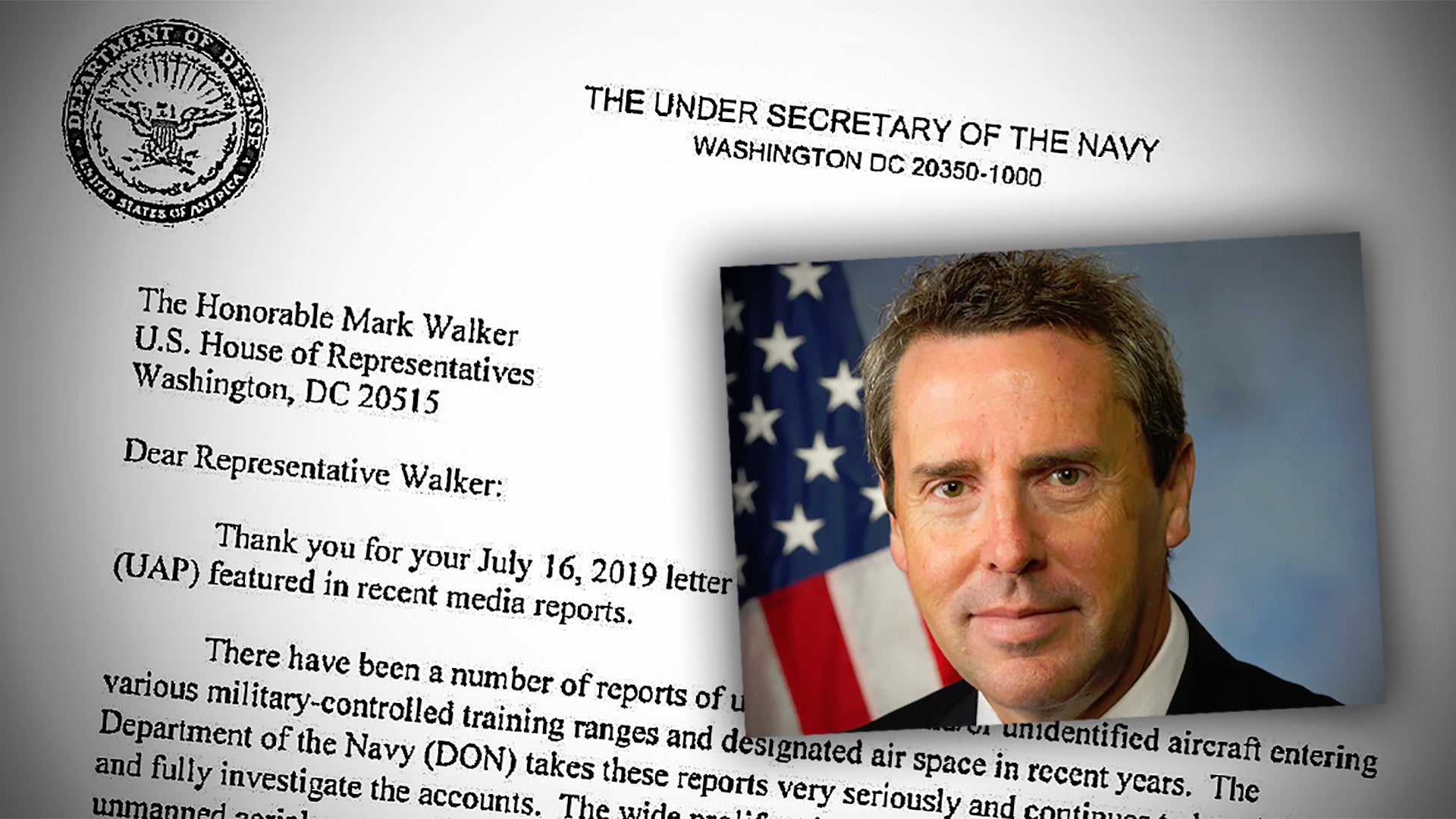Last year, Congressman Mark Walker, a Republican from North Carolina and a member of the House Committee on Homeland Security, wrote a letter to the U.S. Navy demanding answers regarding sightings of what are commonly referred to as unidentified flying objects, or UFOs. Now, The War Zone has obtained a complete copy of the service’s response to these questions about how it is recording and assessing incidents involving what it calls unidentified aerial phenomena, or UAP, which the lawmaker has already said he felt was frustratingly insufficient.
On Mar. 5, 2020, the Navy released an unredacted copy of the letter, which then-Undersecretary of the Navy Thomas Modly wrote on July 31, 2019, in response to a Freedom of Information Act request. Politico was first to report on this letter, after obtaining a copy, in September 2019, but did not publish or otherwise reproduce it in full.
Walker had sent his initial letter, addressed to then-Secretary of the Navy Richard Spencer, on July 16, 2019, and had made a copy publicly available on July 29, which the War Zone
reported on at the time. It is also worth noting that Modly has been Acting Secretary of the Navy since Spencer resigned in November 2019.
“There have been a number of reports of unauthorized and/or unidentified aircraft entering various military-controlled training ranges and designated air space in recent years,” Modly wrote in this July 31 response. “The Department of the Navy (DON) takes these reports very seriously and continues to log sightings and fully investigate the accounts.”
You can read the full letter below.

Modly’s letter makes no mention of a number of high profile UAP incidents involving Navy F/A-18C/D Hornet and F/A-18E/F Super Hornet fighter jets, dating back to at least 2004. You can read more about these particular events in detail in these past
War Zone
It also does not discuss any Navy connection to the Advanced Aerospace Threat and Identification Program (AATIP), or its predecessor, the Advanced Aerospace Weapon System Applications (AAWSA) program, which existed for various periods of time within the Defense Intelligence Agency (DIA) and the Office of the Secretary of Defense. You can find out more about those programs in these previous War Zone pieces.
“The wide proliferation and availability of inexpensive unmanned aerial systems (UAS) has increasingly made airspace de-confliction an issue for our aviators. Naval aircrews have been provided reporting guidance to determine the frequency and location of UAS operating in training areas,” Modly wrote to Walker. “The guidance supports objective, data-driven analysis of incursions. The DON continues to dedicate resources to the tracking and investigation of reports that could affect the safety of our aircrews.”
Walker’s original letter was very clearly asking for information about the highly publicized incidents that fighter pilots had reported both to their superiors and in the press, which involved purported flying craft capable of extreme levels of speed and maneuverability. The Congressman’s inquiry was not explicitly concerned about incidents involving smaller drones breaching restricted airspace around U.S. military facilities or threatening U.S. forces overseas, which has also become an increasing issue in recent years.
“The DON is aligned with the Department of Defense (DoD) and interagency partners on this effort,” Modly’s letter continues. “The DON is leveraging established relationships with sister Services, other DoD offices, the U.S. Intelligence community and other U.S. government agencies that will help us to better understand these incursions into training areas.”
Modly’s letter ends by saying that the Navy would continue to work with the House of Representatives via the House Armed Services Committee, of which Walker is not a member. It does not promise to provide him, or the House Committee on Homeland Security, any of the additional information or data on reported UAP sightings, or “physical evidence” thereof, that he sought.
Walker had sent his letter in the first place because of his position that the reported UAP incidents represented a threat to Homeland Security, including to commercial and civilian aircraft, as well as military ones, flying in U.S. airspace.
Walker’s position is not entirely unreasonable and The War Zone has reported in the past that some of the UAP sightings worried naval aviators for the same basic safety reasons, among other things. The congressman’s comments to Politico last year seem perhaps even more understandable after having read the full text of Modly’s response, as well.
“While I am encouraged the Under Secretary of the Navy confirmed that UAP encounters are fully investigated, there is frustration with the lack of answers to specific questions about the threat that superior aircraft flying in United States airspace may pose,” Walker told that outlet in a statement. “If the Navy believes that China or Russia possesses advanced aerospace technologies that represent a national security vulnerability, the American people have the right to know what their government is doing about it.”
It’s unclear if Walker, or any other members of Congress, have followed up or otherwise succeeded in obtaining additional information on this issue. At least some Senators, as well as President Donald Trump, have received classified briefings on the UAP sightings and what the Navy has been doing in response. However, in September 2019, the Navy told Politico that it had not received any further requests from legislators on this topic since Walker’s letter.
“We are going to stay on the issue and follow through like we said we wanted to do,” Walker had said in his statement at the time.
Whatever the case, the general public safety and national security concerns surrounding UAP sightings that drove Walker to write his original letter certainly haven’t disappeared from the general public consciousnesses.
Contact the author: joe@thedrive.com
